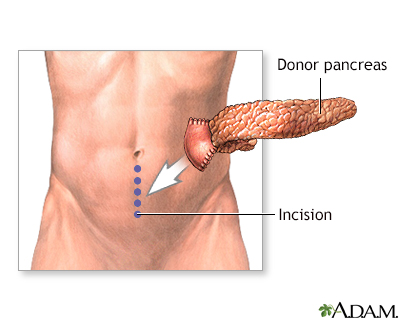Return to Index
Step 1: Taking Charge
Step 2: What is Diabetes?
Step 3: Symptoms of Diabetes
Step 4: Diagnosing Diabetes
Step 5: Your Management Program
Step 6: Use Insulin Every Day
Step 7: Follow a Meal Plan
Step 8: Monitor Blood Glucose
Step 9: Exercise is Important!
Step 10: Recognize Medical Emergencies
Step 11: Long-Term Complications
Step 12: Maintain Regular Check-ups
Step 13: The Healthcare Team
Key Points
Glossary
*Close Menu*
Return to Index
Step 1: Taking Charge
Step 2: What is Diabetes?
Step 3: Symptoms of Diabetes
Step 4: Diagnosing Diabetes
Step 5: Your Management Program
Step 6: Use Insulin Every Day
Step 7: Follow a Meal Plan
Step 8: Monitor Blood Glucose
Step 9: Exercise is Important!
Step 10: Recognize Medical Emergencies
Step 11: Long-Term Complications
Step 12: Maintain Regular Check-ups
Step 13: The Healthcare Team
Key Points
Glossary
*Close Menu*
| Presentation: Pancreas transplant procedure |
| 1 | 2 | 3 | 4 | 5 | 6 |
Review Date:
6/24/2011
Reviewed By: Nancy J. Rennert, MD, FACE, FACP, Chief of Endocrinology & Diabetes, Norwalk Hospital, Associate Clinical Professor of Medicine, Yale School of Medicine, New Haven, CT. Review provided by VeriMed Healthcare Network. Also reviewed by David Zieve, MD, MHA, Medical Director, A.D.A.M., Inc.
Reviewed By: Nancy J. Rennert, MD, FACE, FACP, Chief of Endocrinology & Diabetes, Norwalk Hospital, Associate Clinical Professor of Medicine, Yale School of Medicine, New Haven, CT. Review provided by VeriMed Healthcare Network. Also reviewed by David Zieve, MD, MHA, Medical Director, A.D.A.M., Inc.
The information provided herein should not be used during any medical emergency or for the diagnosis or treatment of any medical condition. A licensed medical professional should be consulted for diagnosis and treatment of any and all medical conditions. Links to other sites are provided for information only -- they do not constitute endorsements of those other sites. No warranty of any kind, either expressed or implied, is made as to the accuracy, reliability, timeliness, or correctness of any translations made by a third-party service of the information provided herein into any other language. © 1997-
A.D.A.M., a business unit of Ebix, Inc. Any duplication or distribution of the information contained herein is strictly prohibited.
A.D.A.M. content is best viewed in IE9 or above, Firefox and Google Chrome browser.






